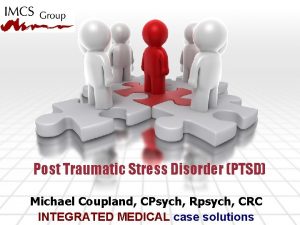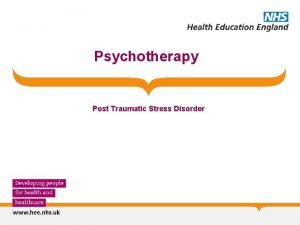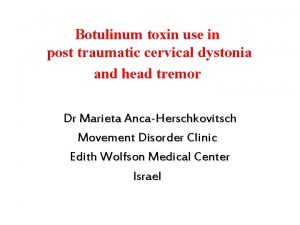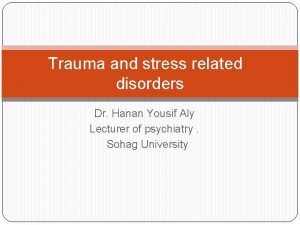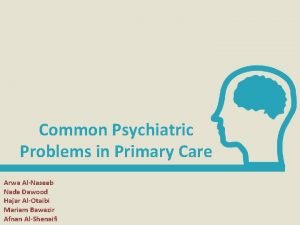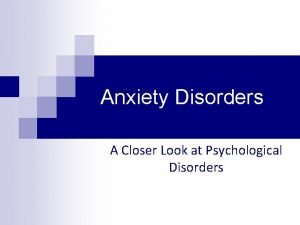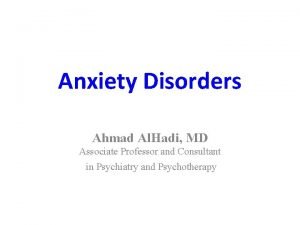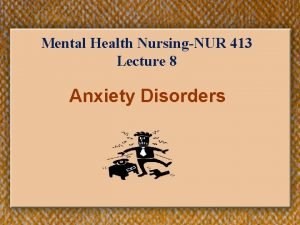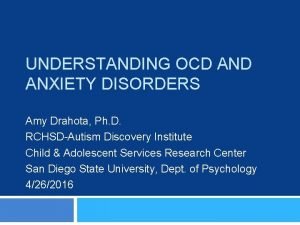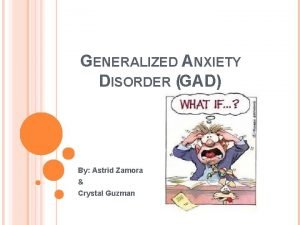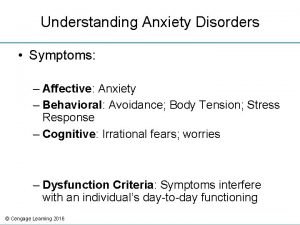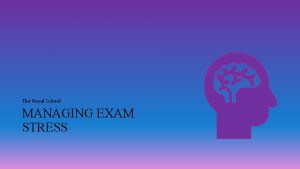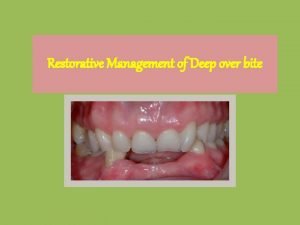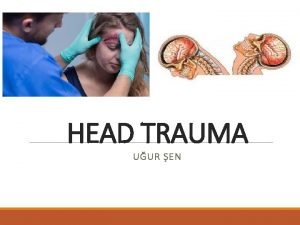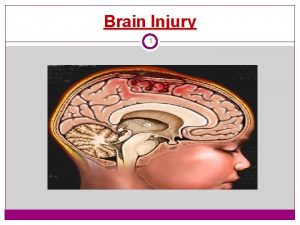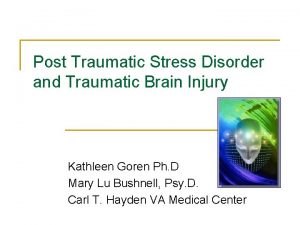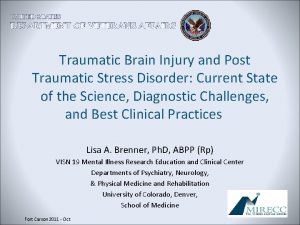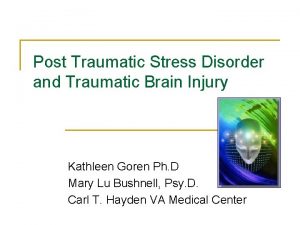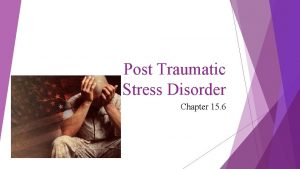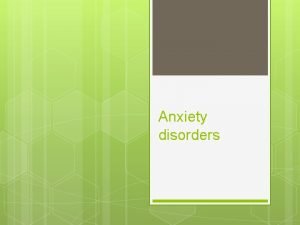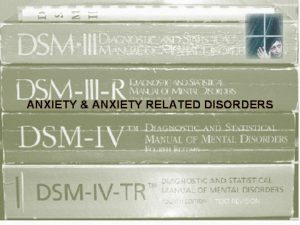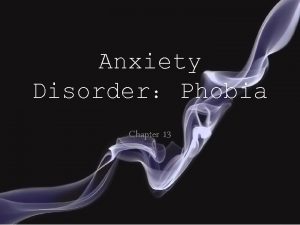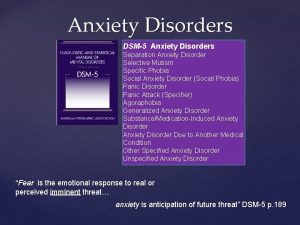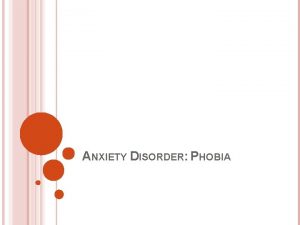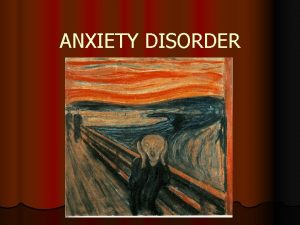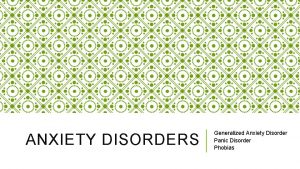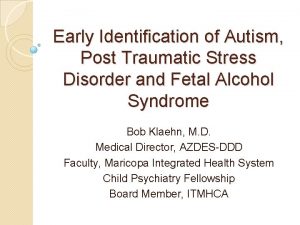Anxiety Disorder Post Traumatic Stress Disorder Ms Carmelitano



















- Slides: 19

Anxiety Disorder: Post Traumatic Stress Disorder Ms. Carmelitano

Anxiety Disorders • Disorders that cause the sufferer to have irrational fear as the main disturbance ▫ ▫ PTSD OCD Social Anxiety Disorder Phobia

Post Traumatic Stress Disorder • Characterized by ▫ ▫ ▫ ▫ Intrusive memories of a past traumatic event Emotional withdrawal Heightened automatic arousal Insomnia Hyper-vigilance Loss of control over anger or aggression Anhedonia – an inability to feel positive emotions • Symptoms must last for more than 30 days • Symptoms occur after a person experiences a traumatic event and are triggered by certain stressors

Prevalence • Davidson et al (2007) and Breslau et al (1998) estimate PST affects 15 -24% of people who are exposed to traumatic events • Lifetime prevalence of 5% in men and 10% in women • People at risk: Those who experience traumatic events ▫ 50% of rape victims will develop PTSD ▫ 20% of those who experience war will develop PTSD ▫ 3% of people who suffer personal attack will develop PTSD ▫ 1/3 of all PTSD suffers have lost a love

Difficulty of Diagnosis • Other diseases frequently occur with it ▫ ▫ Depression Substance abuse Memory and cognitive difficulties Social impairment

Symptoms of PTSD • Affective: ▫ Ahedonia, emotional numbing • Behavioral: ▫ Hyper-vigilance, passivity, nightmares, flashbacks, exaggerated startle response • Cognitive: ▫ Intrusive memories, inability to concentrate, hyper vigilant • Somatic: ▫ Lower back pain, headaches, stomach aches, insomnia, regression, losing developmental skills

Question to answer • Why do only 25% of people who experience a traumatic event develop PTSD? ▫ The answer lies in the etiology! �Biological �Genetics, Brain defects, hormones, neurotransmitters �Cognitive �Schema processing, attribution style �Sociocultural �Social support after a traumatic event

Biological Etiology • Genetic predisposition ▫ Twin Research – Hauff and Vaglum 1994 ▫ Found that there was higher concordance rate of PTSD in identical twins that in fraternal twins �This supports the idea that people will be more prone to developing PTSD after a traumatic event if they have the genetic predisposition �However: this gene has not been discovered

Biological Etiology • The “flight or fight” response is the body’s way of defense in a high-stress situation ▫ The hormone adrenaline is released for a quick response ▫ After the situation, cortisol is released to shut down the stress response • A lack of cortisol results in the body’s stress response being active

Neurotransmitters • Noradrenaline (norepinephrine) – plays a role in arousal ▫ When a person is in a dangerous situation, they have an increase in levels of Noradrenaline. ▫ When these levels do not return to normal, a person may be more prone to develop PTSD • Geracioti (2001): Found that PTSD patients had a higher level of noradrenaline than average patients ▫ When these patient’s adrenal systems were stimulated (causing production of norepinephrine) � 40% had flashbacks and 70% had panic attacks � 0% of the control experienced these symptoms • Bremner 1998: Found evidence of increased sensitivity of noradrenaline receptors in patients

The Brain (Bremner 1997) • When a person experiences a dangers situation the brain switches from “learning mode” to “survival mode” • PET scans have shown that the amygdala (emotional memories) is more responsive in PTSD patients than control subjects ▫ In a PET scan, it produces a darker color image than a control • These patients have a less active prefrontal cortex (impulse control)

Cognitive Etiology • Theory that individual cognitions play a role in the formation of PTSD ▫ PTSD patients may cognitively process experiences differently than others (due to their schemas) ▫ PTSD patients may also have a faulty attribution style • PTSD patients often feel that they do not have control over their lives and the world is unpredictable ▫ A person with these schemas may be more likely to develop PTSD after a traumatic event ▫ The event reinforces the ideas they already have • Intrusive memories come randomly, triggered by sounds, smells, or sights related to a past traumatic event

Brewin et al (1996) • Dual Representation Theory ▫ There are two types of trauma-related memories �Situational accessible memories: Visual intrusions, flash-backs, nightmares - Involuntary recall 0 f non-verbal memories (visual, auditory, sensory) �Information is accompanied by a strong emotional response and bodily sensations �Perceived as ongoing here and now �Verbally accessible memories: Voluntary recall in a verbal or narrative memory �Experienced as a “bad memory” • Flashbacks occur as a result of cue-dependent memory • A stimuli similar to the original event triggers sensory and emotional aspects of the memory causing panic (flashbulb memories in the amygdala)

Sutker et al 1995 • Theorized that PTSD is associated with the tendency to take personal responsibility for failures and to cope with stress by focusing on emotion rather than the problem (attribution) ▫ Gulf War Veterans who had a sense of purpose and commitment to the military had less of a chance of suffering from PTSD • Victims of child abuse who see the abuse is not their fault, will be less likely to develop PTSD

Sutker et al (1995) • Participants: Troops assigned to Marines, Air Force, Navy, Army Reserve, and National Guard who were deployed to combat during the Persian Gulf War ▫ 484 participants. 88% Male and 12% female ▫ Control: 97 87% male and 13% female • Correlational study examining PTSD positive and PTSD negative veterans on personal and environmental resources available • Conclusions: PTST positive veterans reported less satisfaction with social support, less family cohesion and expressiveness, and more avoidant coping mechanisms. They had more self-blame and wishful thinking than the PTSD negative veterans

Suedfeld 2003 • Showed the role attribution style plays in PTSD • Examined attribution of Holocaust survivors ▫ Found that they attribute their survival to external factors (situational) – luck, God, fate, help from others ▫ While a control group of Jewish citizens attributed others survival to dispositional factors ▫ The result is higher chances for a person to develop PTSD because they feel that the situation was out of their control

Sociocultural Etiology • Most research on PTSD looks at the role situational experiences play • If a person has enough emotional support, they are less likely to develop PTSD after experiencing a traumatic event

Racism • Roysircar (2000) ▫ Conducted a meta-analysis of research on Vietnam War veterans • Found: ▫ 20. 6% of War veterans with PTSD were African American ▫ 26. 6% of War veterans with PTSD were Hispanic ▫ 13% of War veterans with PTSD were white • Roysircar argues that pervious racism and oppression predisposed these soldiers to develop PTSD later in life due to traumatic experiences

Dyregrov (2000) • Studied PTSD child survivors of the Rwandan Genocide • UNICEF conducted a survey of 3000 Rwandan children age 8 -19 ▫ 95% had witnessed violence ▫ 80% suffered death in their immediate family ▫ 62% had been threatened with death �These children still live in the same area and lack social support to cope with the events of the Genocide, having been orphaned ▫ Over 60% percent suffer PTSD because of their experience and lack of social support
 Diagnosis of post traumatic stress disorder
Diagnosis of post traumatic stress disorder Post traumatic stress disorder
Post traumatic stress disorder Complex ptsd
Complex ptsd Post-traumatic cervical dystonia
Post-traumatic cervical dystonia Post trumatic stress disorder
Post trumatic stress disorder Generalized anxiety disorder dsm 5
Generalized anxiety disorder dsm 5 Explanation of anxiety disorder
Explanation of anxiety disorder Powerlessness nursing diagnosis
Powerlessness nursing diagnosis Agoraphobia vs social phobia
Agoraphobia vs social phobia Examples of generalized anxiety disorder
Examples of generalized anxiety disorder Explanation of anxiety disorder
Explanation of anxiety disorder Astrid zamora
Astrid zamora Biopsychosocial ocd
Biopsychosocial ocd Chapter 8 managing stress and anxiety
Chapter 8 managing stress and anxiety Difference between anxiety and stress
Difference between anxiety and stress Stress anxiety depression
Stress anxiety depression Traumatic overbite definition
Traumatic overbite definition Tbi long term servival after traumatic
Tbi long term servival after traumatic Raccoon
Raccoon Halo effect csf
Halo effect csf
